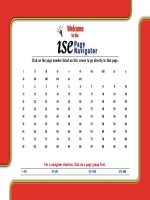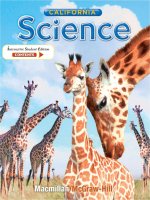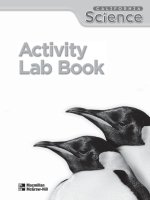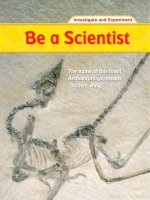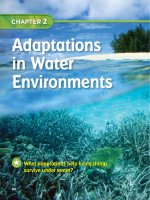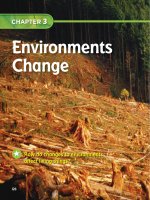- Trang chủ >>
- THPT Quốc Gia >>
- Hóa
California science grade 2 (1)
Bạn đang xem bản rút gọn của tài liệu. Xem và tải ngay bản đầy đủ của tài liệu tại đây (5.77 MB, 165 trang )
All photographs are by Macmillan/McGraw-Hill (MMH) except as noted below.
Cover Photos: (bkgd) David Keith Jones/Images of Africa Photobank/Alamy; (sky) Digital Vision/PunchStock;
(inset) Joseph Van Os/The Image Bank/Getty Images.
Science Content Standards for California Public Schools reproduced by permission, California Department of Education, CDE
Press, 1430 N Street, Suite 3207, Sacramento, CA 95814.
Published by Macmillan/McGraw-Hill, of McGraw-Hill Education, a division of The McGraw-Hill Companies, Inc.,
Two Penn Plaza, New York, New York 10121.
Copyright © by Macmillan/McGraw-Hill. All rights reserved. No part of this publication may be reproduced
or distributed in any form or by any means, or stored in a database or retrieval system, without the prior written consent
of The McGraw-Hill Companies, Inc., including, but not limited to, network storage or transmission, or broadcast for
distance learning.
Printed in the United States of America
1 2 3 4 5 6 7 8 9 079 09 08 07 06
A
Contents
LIFE SCIENCE
Chapter 1
Plant Life Cycles . . . . . . . . . . . . . . . . . . . . . . . . . . . . . . . . . . . . . . 1
Chapter 2
Life Cycles of Animals . . . . . . . . . . . . . . . . . . . . . . . . . . . . . . . . 21
EARTH SCIENCE
Chapter 3
Earth’s Materials. . . . . . . . . . . . . . . . . . . . . . . . . . . . . . . . . . . . . 41
Chapter 4
Earth’s Past . . . . . . . . . . . . . . . . . . . . . . . . . . . . . . . . . . . . . . . . . 57
Chapter 5
Earth’s Resources . . . . . . . . . . . . . . . . . . . . . . . . . . . . . . . . . . . 73
PHYSICAL SCIENCE
Chapter 6
Objects in Motion . . . . . . . . . . . . . . . . . . . . . . . . . . . . . . . . . . . 89
Chapter 7
Forces at Work . . . . . . . . . . . . . . . . . . . . . . . . . . . . . . . . . . . . . 109
Everyday Science Activities . . . . . . . . . . . . . . . . . . . . . . . . . . . . . . . . . . . . . 129
© Macmillan/McGraw-Hill
Learning Labs . . . . . . . . . . . . . . . . . . . . . . . . . . . . . . . . . . . . . . . . . . . . . . . . . 145
California science standards are noted at the top of activity pages. For the text of the
standards, please refer to the Reference section of the California Science Student Edition.
Activity Lab Book
iii
Name
Date
Explore
California Standard
2 IE 4.c.
How are leaves alike
and different?
You need
What to Do
& Observe. Use a hand lens to
• hand lens
• leaves
observe leaves.
' Communicate. Draw pictures of what you see in
the box below. What questions do you have?
Chapter 1 • Plant Life Cycles
Activity Lab Book
Use with Lesson 1
Plants and Their Parts
1
Explore
Name
Date
( Compare. How are the leaves alike and different?
Explore More
) Classify. Sort the leaves into groups. Draw and
© Macmillan / McGraw-Hill
label each group you made in the box below.
2
Chapter 1 • Plant Life Cycles
Activity Lab Book
Use with Lesson 1
Plants and Their Parts
Name
Alternative
Explore
Date
Which leaf do you have?
In this activity, you will discuss and
compare six different leaves.
You need
• leaves
What to Do
& Write four words that tell about your leaf.
' Find a classmate with the same kind of leaf as
yours. How did you find people with the same kind
of leaf as yours?
( Find a classmate with a different kind of leaf than
the one you have. How is your leaf different from
© Macmillan / McGraw-Hill
your classmate’s leaf?
Chapter 1 • Plant Life Cycles
Activity Lab Book
Use with Lesson 1
Plants and Their Parts
3
Quick Lab
Name
Date
What are the parts of plants?
What to Do
& Separate your plant from the soil.
Look for the roots.
' Observe. Look at the different
You need
• plants with
flowers
• hand lens
parts of the plant. What parts can
you see?
( Communicate. Draw a picture of the plant on a
separate piece of paper. Label the parts that
you see.
What Did You Find Out?
* Predict. Where do you think the fruit and seeds
will be?
4
Chapter 1 • Plant Life Cycles
Activity Lab Book
Use with Lesson 1
Plants and Their Parts
© Macmillan / McGraw-Hill
) Infer. Why are there no fruits or seeds?
Name
Date
Observe
Focus on
Skills
California Standard
2 IE 4.d.
To observe, you use your senses to find out about
something. You use senses to see, feel, hear, smell,
and taste.
Learn It
You can use some of your senses to learn about flowers.
You can write what you observe in a chart.
© Macmillan / McGraw-Hill
jasmine
Chapter 1 • Plant Life Cycles
Activity Lab Book
Use with Lesson 1
Plants and Their Parts
5
Focus on
Skills
Name
Date
Try It
Find a flower to observe or look at the pictures below.
& What color is your flower? Which sense did you use
to find out?
' How do you think the leaves feel?
© Macmillan / McGraw-Hill
( Write About It. Find another flower and compare.
6
Chapter 1 • Plant Life Cycles
Activity Lab Book
Use with Lesson 1
Plants and Their Parts
Name
Date
What are the parts
of a seed?
Explore
California Standard
2 IE 4.f.
You need
What to Do
& Observe. Look at the dry lima bean.
What does it feel like?
• dry lima
bean
• wet lima
bean
• hand lens
' Observe. Look at the wet lima bean. What do you
© Macmillan / McGraw-Hill
see? What questions do you have about the seeds?
Chapter 1 • Plant Life Cycles
Activity Lab Book
Use with Lesson 2
Flowers and Fruits
7
Explore
Name
Date
( Use your fingernail to open the wet lima bean. Use
a hand lens to look inside. Draw a picture of what
you see in the box below.
) Communicate. How did the water change the
bean?
Explore More
# Predict. Do other kinds
© Macmillan / McGraw-Hill
of beans look the same
inside? Try it.
8
Chapter 1 • Plant Life Cycles
Activity Lab Book
Use with Lesson 2
Flowers and Fruits
Name
Alternative
Explore
Date
What are the parts of seeds?
In this activity, you will label the parts of a seed.
What to Do
& Look at the diagram below of the inside and
outside of a bean seed.
Bean Seed
' Label the seed coat.
( Label the area of the seed where food is stored.
© Macmillan / McGraw-Hill
) Label the part of the seed where a new plant will
grow.
Chapter 1 • Plant Life Cycles
Activity Lab Book
Use with Lesson 2
Flowers and Fruits
9
Quick Lab
Name
Date
What plants grow from seeds?
What to Do
You need
& Observe. Choose three different
seeds. Use your senses to study them
• packets of
seeds
closely. Write your observations in the
chart below.
What Do
You See?
What Do
You Feel?
What Do
You Smell?
Seed #1
Seed #2
Seed #3
' Compare. Look at the pictures of the plants and
compare them with the seeds. Can you match the
© Macmillan / McGraw-Hill
picture of the plant with its seed? Explain.
10
Chapter 1 • Plant Life Cycles
Activity Lab Book
Use with Lesson 2
Flowers and Fruits
Name
Date
Explore
California Standard
2 IE 4.d.
What will grow from a seed?
What to Do
& Use toothpicks to hold your seed
in a cup of water.
You need
• toothpicks
• avocado
seed
• cup
' Observe. Watch how your plant grows. Remember
to add water so that the bottom of the seed is
© Macmillan / McGraw-Hill
always in water.
Chapter 1 • Plant Life Cycles
Activity Lab Book
Use with Lesson 3
Plants Grow and Change
11
Explore
Name
Date
( Draw pictures of your plant as it grows in the box
below. What plant part grew first? What other
parts did your seed grow?
Explore More
© Macmillan / McGraw-Hill
) Predict. How will your plant change as it grows?
12
Chapter 1 • Plant Life Cycles
Activity Lab Book
Use with Lesson 3
Plants Grow and Change
Name
Date
Alternative
Explore
How are young and adult plants alike?
What to Do
& Compare. Look at the picture of a
young apple tree and the picture of
an older apple tree.
' How are the young apple tree
You need
• pictures of a
young apple
tree and an
older apple
tree
and the older apple tree alike?
• 1 apple, cut in
half
How are they different?
• hand lens
( Observe. Look at the apple that has been cut in
half. Use a hand lens. What do you think these
© Macmillan / McGraw-Hill
seeds will grow to look like?
Chapter 1 • Plant Life Cycles
Activity Lab Book
Use with Lesson 3
Plants Grow and Change
13
Quick Lab
Name
Date
What is the order of a life cycle?
What to Do
parts of a tree’s life cycle in
the pictures below.
• construction
paper
• glue
' Sequence. Cut out the pictures with the lines.
Put them in the correct life cycle order. Glue the
pictures with the lines to construction paper.
( Communicate. On the lines under each picture,
write a sentence to tell about each picture.
14
Chapter 1 • Plant Life Cycles
Activity Lab Book
Use with Lesson 3
Plants Grow and Change
© Macmillan / McGraw-Hill
& Observe. Look at the different
You need
Name
Date
How are wildflowers alike
and different?
Be a
Scientist
California Standard
2 IE 4.e.
You need
What to Do
& Classify. Sort the seeds to find ones
that look alike. Put the different
• mixed
wildflower
seeds
types of seeds in an egg carton. Pick
• egg
carton
three different types. You will need
• 3 cups
2 or 3 seeds of each type.
• soil
' Number the cups. Fill the cups with soil. Plant one
© Macmillan / McGraw-Hill
type of seed in each cup.
Chapter 1 • Plant Life Cycles
Activity Lab Book
Use with Lesson 3
Plants Grow and Change
15
Be a
Scientist
Name
Date
( Water the seeds. Put the
seeds in a sunny place.
) Observe. Watch your
seeds as they grow.
Record what you see
every day. Make a chart
like the one below. How long do the seeds take to
sprout? What shapes are the leaves? How are the
flowers alike and different?
Cup
Day
1
1
2
3
3
Investigate More
Use the library or the Internet to find out the names of
the plants you grew.
16
Chapter 1 • Plant Life Cycles
Activity Lab Book
Use with Lesson 3
Plants Grow and Change
© Macmillan / McGraw-Hill
2
Name
Date
Explore
California Standard
2 IE 4.d.
How do roots grow?
What to Do
You need
& Put a bean seed on a damp paper
• bean seed
towel. Put it in the bag and tape it
• paper
towel
to a window.
' Observe. Watch the seed as it grows.
Which part grows first? Which way
do the roots grow?
• plastic bag
• tape
• hand lens
( After the roots have started to grow, turn the bag
upside down. Tape it to the window again. Make
© Macmillan / McGraw-Hill
sure the paper towel stays wet.
Chapter 1 • Plant Life Cycles
Activity Lab Book
Use with Lesson 4
Plants and Their Environments
17
Explore
Name
Date
Explore More
) Communicate. Draw what happened to the roots
© Macmillan / McGraw-Hill
in the box below.
18
Chapter 1 • Plant Life Cycles
Activity Lab Book
Use with Lesson 4
Plants and Their Environments
Name
Alternative
Explore
Date
What makes seeds grow down?
What to Do
You need
Observe the roots that grow from
bean seeds.
• 4 bean seeds
• plastic bag
& Place 4 beans in a plastic bag. Turn
the beans in different directions. Put
• moist paper
towel
a moist paper towel in the bag with
the beans.
' Look at the bean seeds every day until the roots
begin to grow.
( Discuss how the beans change each day.
What Did You Find Out?
© Macmillan / McGraw-Hill
& How did the roots of each seed grow?
' How do you think the roots know which way is down?
( Why do roots grow down?
Chapter 1 • Plant Life Cycles
Activity Lab Book
Use with Lesson 4
Plants and Their Environments
19
Quick Lab
Name
Date
Do plants grow toward light?
& Put one plant in the shoebox on the
end away from the hole. Tightly close
the box. Make sure that the only
light getting into the box is
coming through the hole.
' Put the box and the other plant on
the windowsill. The hole in the box
should be facing the light. Only open
the box to water the plant.
You need
• a shoebox
(with a hole
cut on the
top righthand side)
• two of the
same kind of
wildflower
plants
• water
( Observe. After one week, look at the
plant in the box. Draw what you see
on a separate piece of paper.
) Compare. How is the plant in the box different
* Why did it change to fit its new environment?
20
Chapter 1 • Plant Life Cycles
Activity Lab Book
Use with Lesson 4
Plants and Their Environments
© Macmillan / McGraw-Hill
from the plant not in the box?
Name
Date
Explore
How can we put animals into groups?
What to Do
California Standard
2 IE 4.c.
& Classify. Make a list of ten animals. Put your
animals into groups. What groups did you use?
Sea Turtle
Seagull
© Macmillan / McGraw-Hill
Dolphin
Sea Otter
Lobster
Chapter 2 • Life Cycles of Animals
Activity Lab Book
Use with Lesson 1
Kinds of Animals
21
Explore
Name
Date
' Talk about your animal groups with a partner. What
groups did your partner use?
( Compare. How are your groups and your partner’s
groups alike? How are they different?
Explore More
) Infer. Why do you think scientists put animals into
© Macmillan / McGraw-Hill
groups?
22
Chapter 2 • Life Cycles of Animals
Activity Lab Book
Use with Lesson 1
Kinds of Animals

